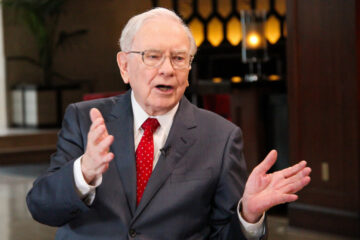U.S. equity futures tumbled in early Monday trading, while Treasury bonds and gold prices rallied, as global markets reacted to the threat of damaging trade tariffs from President Donald Trump that could tip the world’s biggest economy into recession over the coming months.
President Trump told reporters on Air Force One last night that the so-called reciprocal tariffs he plans to imposed on Wednesday will apply to “all countries”, and not just a select group with large and persistent trade imbalances, as had been previously suggested from Administration insiders.
The broader scope of the tariff plan, alongside threats to create ‘secondary’ levies on the sale of Russian crude if Trump fails to strike a deal with President Vladimir Putin to end that country’s war on Ukraine, has raised the prospect of a sharp global slowdown and stoked demand for safe-have assets.
Goldman Sachs, in fact, lifted the odds of a U.S. recession over the next twelve months to 35%, from a prior call of 20%, citing “the sharp recent deterioration in household and business confidence, and statements from White House officials indicating greater willingness to tolerate near-term economic weakness in pursuit of their policies.”
President Donald Trump told reporters on Air Force One last night that so-called ‘reciprocal’ tariffs will “start with all countries” later this week.
Andrew Harnik/Getty Images
The bank also sees fist quarter GDP growth of just 0.2%, down from a 1.8% forecast at the stat of the year, and expects the S&P 500 to fall another 5%, to around 5,300 points, over the next three months.
Those projects, which are starting to echo across Wall Street, helped drive gold prices to a fresh all-time high of $3,115.97 per ounce in overnight trading, the bullion’s fifteenth record of the year, while sparking another rally in safe-haven Treasuries.
Benchmark 10-year note yields were last marked 6 basis points lower from Friday levels at 4.192% heading into the start of the New York trading session, with 2-year notes trading 6 basis points lower at 3.846%.
Related: Fed inflation gauge shows early tariff impact
On Wall Street, the S&P 500 is set to open 55 points lower at the start of trading, a move that would take it to within 5 points of its closing low on March 13 and drag the benchmark back into correction territory based on the all-time high it printed on February 19.
The S&P 500 is, in fact, on pace for its weakest first quarter in five years, and the worst overall quarterly performance in three, thanks in part to outsized pullbacks for megacap tech stocks and a broader rotation into European equities.
The market’s benchmark volatility gauge, the CBOE Group’s VIX index, surged 25.28% higher in overnight trading to $23.97, a level that suggests daily swings of 1.5%, or 83 points, for the S&P 500.
The tech-focused Nasdaq, which is down 8.1% for the month and more than 10.3% for the year, is priced for a 255 point opening bell decline with the Dow Jones Industrial Average called 280 points lower.
More Economic Analysis:
Gold’s price hit a speed bump; where does it go from here?7 takeaways from Fed Chairman Jerome Powell’s remarksRetail sales add new complication to Fed rate cut forecasts
In Europe, the Stoxx 600 was marked 1.28% lower in mid-day Frankfurt trading, with Britain’s FTSE 100 falling 1.03% in London.
Overnight in Asia, Japan’s auto-heavy Nikkei 225 tumbled 4.05%, taking the benchmark to the lowest levels in six months, ahead of both the new ‘reciprocal’ tariffs and planned auto sector tariffs which will imposed later in the week.
The region-wide MSCI ex-Japan benchmark, meanwhile, fell 1.88% lower into the close of trading.
Related: Veteran fund manager unveils eye-popping S&P 500 forecast


